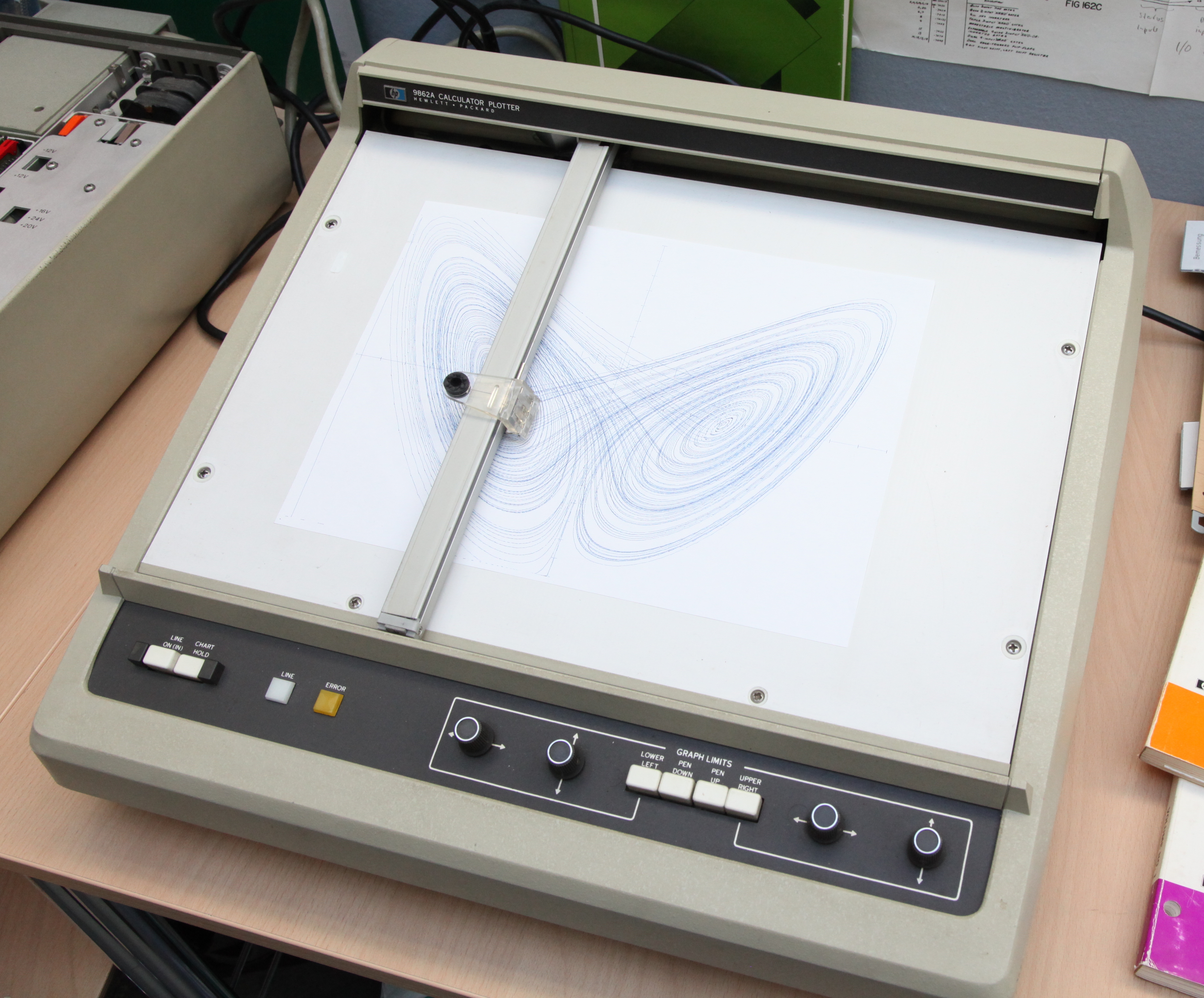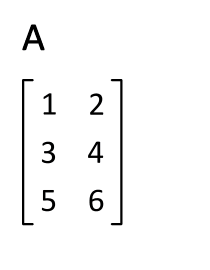|
Plotter
A plotter is a machine that produces vector graphics drawings. Plotters draw lines on paper using a pen, or in some applications, use a knife to cut a material like Polyvinyl chloride, vinyl or leather. In the latter case, they are sometimes known as a cutting plotter. In the past, plotters were used in applications such as computer-aided design, as they were able to produce line drawings much faster and of a higher quality than contemporary conventional printers. Smaller desktop plotters were often used for business graphics. Printers with graphics capabilities took away some of the market by the early 1980s, and the introduction of laser printers in the mid-1980s largely eliminated the use of plotters from most roles. Plotters retained a niche for producing very large drawings for many years, but have now largely been replaced by wide-format printer, wide-format conventional printers. Cutting plotters remain in use in a number of industries. Overview Digitally controlled pl ... [...More Info...] [...Related Items...] OR: [Wikipedia] [Google] [Baidu] |
Electrostatic Plotter
An electrostatic plotter is a type of plotter that draws images on paper with an electrostatic process. They are most frequently used for Computer-Aided Engineering (CAE), producing raster images via either a Liquid Toner or a Dry Toner model. Liquid Toner models use toner that is positively charged and thus becomes attracted to paper's negative charge. This occurs after the toner particles pass through a line of electrodes in the form of tiny wires, or nibs. The spacing of the wires controls the resolution of the plotter; for example, 100 or 400 wires to the inch. Dry Toner models use a process similar to xerography in photocopiers. Unlike a laser printer or photocopier, there is no transfer drum used in most electrostatic plotters; the imaging paper is directly exposed to the charging electrode array. Electrostatic plotters can print in black and white or in color. Some models handle paper sizes up to six feet wide. Newer versions are large-format laser printers and focus light ... [...More Info...] [...Related Items...] OR: [Wikipedia] [Google] [Baidu] |
Computer Printer
A printer is a peripheral machine which makes a durable representation of graphics or text, usually on paper. While most output is human-readable, bar code printers are an example of an expanded use for printers. Different types of printers include 3D printers, inkjet printers, laser printers, and thermal printers. History The first computer printer designed was a mechanically driven apparatus by Charles Babbage for his difference engine in the 19th century; however, his mechanical printer design was not built until 2000. He also had plans for a curve plotter, which would have been the first computer graphics printer if it was built. The first patented printing mechanism for applying a marking medium to a recording medium or more particularly an electrostatic inking apparatus and a method for electrostatically depositing ink on controlled areas of a receiving medium, was in 1962 by C. R. Winston, Teletype Corporation, using continuous inkjet printing. The ink was a red sta ... [...More Info...] [...Related Items...] OR: [Wikipedia] [Google] [Baidu] |
Raster Graphics
upright=1, The Smiley, smiley face in the top left corner is a raster image. When enlarged, individual pixels appear as squares. Enlarging further, each pixel can be analyzed, with their colors constructed through combination of the values for red, green and blue. In computer graphics and digital photography, a raster graphic, raster image, or simply raster is a two-dimensional image or picture represented as a rectangular Matrix (mathematics), matrix or grid of pixels, viewable via a computer display, paper, or other display medium. A raster image is technically characterized by the width and height of the image in pixels and by the number of bits per pixel. Raster images are stored in image files with varying dissemination, production, generation, and acquisition formats. The printing and prepress industries know raster graphics as contones (from "continuous tones"). In contrast, '' line art'' is usually implemented as vector graphics in digital systems. Many raster ... [...More Info...] [...Related Items...] OR: [Wikipedia] [Google] [Baidu] |
Decal
A decal (, , ) or transfer is a plastic, cloth, paper, or ceramic substrate that has printed on it a pattern or image that can be moved to another surface upon contact, usually with the aid of heat or water. The word is short for '' decalcomania'', a decorative technique by which engravings and prints are transferred to pottery or other materials. The technique was invented by Simon François Ravenet (1706-1774), an engraver from France who later moved to England and perfected the process he called "décalquer" (which means "to copy by tracing"); it became widespread during the decal craze or mania of the late 19th century. Properties The term "decal" refers to the mass-produced art transfer in two different states: 1. As manufactured, which consists of the artwork printed on the upper side of a paper or film label stock, temporarily affixed by a typically water or heat soluble adhesive to the upper side of a silicone- or other release agent-coated paper or film backing ... [...More Info...] [...Related Items...] OR: [Wikipedia] [Google] [Baidu] |
Scrapbooking
Scrapbooking is a method of preserving, presenting, and arranging personal and family history in the form of a book, box, or card. Typical memorabilia include photographs, printed media, and artwork. Scrapbook albums are often decorated and frequently contain extensive journal entries or written descriptions. Scrapbooking started in the United Kingdom in the nineteenth century. History In the 15th century, commonplace books, popular in England, emerged as a way to compile information that included recipes, quotations, letters, poems, and more. Each commonplace book was unique to its creator's particular interests. Friendship albums became popular in the 16th century. These albums were used much like modern day yearbooks, where friends or patrons would enter their names, titles and short texts or illustrations at the request of the album's owner. These albums were often created as souvenirs of European tours and would contain local memorabilia including coats of arms or works ... [...More Info...] [...Related Items...] OR: [Wikipedia] [Google] [Baidu] |
Wide-format Printer
Wide format printers (large format printers) are generally accepted to be any computer-controlled printing machines (printers) that support a maximum print roll width of between . Printers with capacities over wide are considered ''super-wide'' or ''grand'' format. Wide-format printers are used to print banners, posters, trade show graphics, wallpaper, murals, backlit film ( duratrans), vehicle image wraps, electronic circuit schematics, architectural drawings, construction plans, backdrops for theatrical and media sets, and any other large format artwork or signage. Wide-format printers usually employ some variant of inkjet or toner-based technology to produce the printed image; and are more economical than other print methods such as screen printing Screen printing is a printing technique where a mesh is used to transfer ink (or dye) onto a substrate, except in areas made impermeable to the ink by a blocking stencil. A blade or squeegee is moved across the screen ... [...More Info...] [...Related Items...] OR: [Wikipedia] [Google] [Baidu] |
Die Cutting (web)
Die cutting is the general process of using a die to shear webs of low-strength materials, such as rubber, fibre, foil, cloth, paper, corrugated fibreboard, chipboard, paperboard, plastics, pressure-sensitive adhesive tapes, foam, and sheet metal. In the metalworking and leather industries, the process is known as clicking and the machine may be referred to as a ''clicking machine''. When a ''dinking die'' or ''dinking machine'' is used, the process is known as dinking. Commonly produced items using this process include gaskets, labels, tokens, corrugated boxes, and envelopes. Die cutting started as a process of cutting leather for the shoe industry in the mid-19th century. It is now sophisticated enough to cut through just one layer of a laminate, so it is now used on labels, postage stamps, and other stickers; this type of die cutting is known as '. Die cutting can be done on either flatbed or rotary presses. Rotary die cutting is often done inline with printing. The p ... [...More Info...] [...Related Items...] OR: [Wikipedia] [Google] [Baidu] |
Polyvinyl Chloride
Polyvinyl chloride (alternatively: poly(vinyl chloride), colloquial: vinyl or polyvinyl; abbreviated: PVC) is the world's third-most widely produced synthetic polymer of plastic (after polyethylene and polypropylene). About 40 million tons of PVC are produced each year. PVC comes in rigid (sometimes abbreviated as RPVC) and flexible forms. Rigid PVC is used in construction for pipes, doors and windows. It is also used in making plastic bottles, packaging, and bank or membership cards. Adding plasticizers makes PVC softer and more flexible. It is used in plumbing, electrical cable insulation, flooring, signage, phonograph records, inflatable products, and in rubber substitutes. With cotton or linen, it is used in the production of canvas. Polyvinyl chloride is a white, brittle solid. It is soluble in ketones, chlorinated solvents, dimethylformamide, THF and DMAc. Discovery PVC was synthesized in 1872 by German chemist Eugen Baumann after extended investigation and experimenta ... [...More Info...] [...Related Items...] OR: [Wikipedia] [Google] [Baidu] |
Wide-format Printer
Wide format printers (large format printers) are generally accepted to be any computer-controlled printing machines (printers) that support a maximum print roll width of between . Printers with capacities over wide are considered ''super-wide'' or ''grand'' format. Wide-format printers are used to print banners, posters, trade show graphics, wallpaper, murals, backlit film ( duratrans), vehicle image wraps, electronic circuit schematics, architectural drawings, construction plans, backdrops for theatrical and media sets, and any other large format artwork or signage. Wide-format printers usually employ some variant of inkjet or toner-based technology to produce the printed image; and are more economical than other print methods such as screen printing Screen printing is a printing technique where a mesh is used to transfer ink (or dye) onto a substrate, except in areas made impermeable to the ink by a blocking stencil. A blade or squeegee is moved across the screen ... [...More Info...] [...Related Items...] OR: [Wikipedia] [Google] [Baidu] |
Vector Graphics
Vector graphics are a form of computer graphics in which visual images are created directly from geometric shapes defined on a Cartesian plane, such as points, lines, curves and polygons. The associated mechanisms may include vector display and printing ''hardware'', vector ''data models'' and file formats, as well as the ''software'' based on these data models (especially graphic design software, computer-aided design, and geographic information systems). Vector graphics are an alternative to raster or bitmap graphics, with each having advantages and disadvantages in specific situations. While vector hardware has largely disappeared in favor of raster-based monitors and printers, vector data and software continue to be widely used, especially when a high degree of geometric precision is required, and when complex information can be decomposed into simple geometric primitives. Thus, it is the preferred model for domains such as engineering, architecture, surveying, 3D r ... [...More Info...] [...Related Items...] OR: [Wikipedia] [Google] [Baidu] |
Cardmaking
Card making is the craft of hand-making greeting cards. It shares skills in common in allied crafts such as scrapbooking and stamping. Unlike handcrafted cards, mass-produced printed greeting cards have been faced with competition from electronic greeting cards. Over seven billion greeting cards were sent in the US each year; greeting cards are a multibillion-dollar business. Many hobbyists taking advantage of the low setup costs of web-based selling and the wide customer-base of auction sites like eBay to market their cards. Many others continue to sell their creations at craft fairs, markets and fêtes. Others use their cardmaking skills to turn a profit in the wedding planning market making handmade wedding invitations and favors. There are many different variations of handmade cards including decoupage, more commonly known as 3D, where a design is printed a number of times, then various areas of the design are cut and layered on top of each other using double-sided stic ... [...More Info...] [...Related Items...] OR: [Wikipedia] [Google] [Baidu] |






